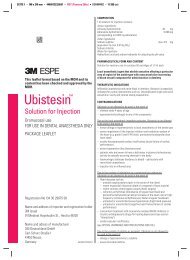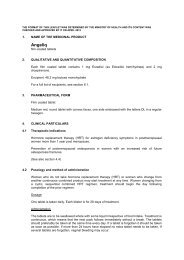Konakion® MM ampoules 2 mg / 0.2 ml paediatric ROCHE
Konakion® MM ampoules 2 mg / 0.2 ml paediatric ROCHE
Konakion® MM ampoules 2 mg / 0.2 ml paediatric ROCHE
Create successful ePaper yourself
Turn your PDF publications into a flip-book with our unique Google optimized e-Paper software.
Konakion ® <strong>MM</strong> <strong>ampoules</strong><br />
2 <strong>mg</strong> / <strong>0.2</strong> <strong>ml</strong> <strong>paediatric</strong><br />
Phytomenadione<br />
<strong>ROCHE</strong><br />
Composition<br />
Active ingredient: phytomenadione (synthetic vitamin K1).<br />
One amber glass ampoule contains <strong>0.2</strong> <strong>ml</strong> of a clear mixed-micelle solution of 2 <strong>mg</strong> vitamin K1<br />
(filling volume 0.3 <strong>ml</strong>) for oral or parenteral administration.<br />
Excipients: glycocholic acid, sodium hydroxide, lecithin, hydrochloric acid, water for injection.<br />
Properties and effects<br />
The presence of vitamin K1, the active ingredient of Konakion <strong>MM</strong> <strong>paediatric</strong>, is essential for the<br />
formation of prothrombin, factors VII, IX and X, and the coagulation inhibitors protein C and<br />
protein S in the body.<br />
Vitamin K1 does not readily cross the placental barrier from mother to child and is poorly<br />
excreted in breast milk.<br />
Lack of vitamin K1 leads to an increased tendency to hemorrhagic disease in the newborn. of<br />
Vitamin K1 administration, which promotes synthesis of the above-mentioned coagulation factors<br />
by the liver, can reverse an abnormal coagulation status and bleeding due to vitamin K1<br />
deficiency.<br />
Pharmacokinetics<br />
In the mixed-micelle solution, vitamin K1 is solubilized by means of a physiological colloidal<br />
system consisting of lecithin and bile acid.<br />
Absorption<br />
Vitamin K1 is absorbed from the small intestine. Absorption is limited in the absence of bile.<br />
1
Distribution<br />
Vitamin K1 accumulates predominantly in the liver. It is up to 90% bound to lipoproteins in the<br />
plasma and is stored in the body only for short periods of time.<br />
Metabolism<br />
Vitamin K1 is converted to more polar metabolites, such as phytomenadione-2,3-epoxide.<br />
Elimination<br />
The half-life of vitamin K1 in plasma is about 1.5 to 3 hours. Vitamin K1 is excreted in the bile<br />
and urine as glucuronide and sulphate conjugates.<br />
Indications and usage<br />
Documented indications<br />
Prophylaxis and treatment of haemorrhagic disease of the newborn.<br />
Dosage and administration<br />
<strong>Konakion®</strong> should be administrated by health professionals only.<br />
Dosage<br />
Prophylaxis<br />
For all healthy neonates:<br />
Oral use<br />
• 2 <strong>mg</strong> orally at birth or shortly after birth, followed by a further 2 <strong>mg</strong> dose four to seven<br />
days later.<br />
• Exclusively breast-fed babies:<br />
In addition to the regimen recommended for all healthy neonates, a 2 <strong>mg</strong> dose should be<br />
given orally after four to six weeks.<br />
Parenteral use<br />
• A single 1 <strong>mg</strong> (0.1 <strong>ml</strong>) given intramuscularly at birth or shortly after birth if the oral route<br />
is unsuitable or if low compliance for multiple oral administration regimen is expected.<br />
• Intramuscular doses should not exceed 0.4 <strong>mg</strong>/kg (equivalent to<br />
0.04 <strong>ml</strong>/kg) in premature infants weighing less than 2.5 kg (see Precautions).<br />
2
Neonates with special risk factors (e.g. prematurity, birth asphyxia, obstructive jaundice,<br />
inability to swallow, maternal use of anticoagulants or antiepileptics):<br />
• 1 <strong>mg</strong> (0.1 <strong>ml</strong>) intramuscularly or intravenously at birth or shortly after birth.<br />
• Intramuscular and intravenous doses should not exceed 0.4 <strong>mg</strong>/kg (equivalent to 0.04 /kg)<br />
in premature infants weighing less than 2.5 kg (see Precautions).<br />
• The size and frequency of further doses should be based on coagulation status.<br />
Therapy<br />
Initially, 1 <strong>mg</strong> (0.1 <strong>ml</strong>) by intravenous injection, with further doses as required, based on the<br />
clinical picture and coagulation status. In certain circumstances, treatment with Konakion <strong>MM</strong><br />
<strong>paediatric</strong> may need to be accompanied by more direct forms of effective haemorrhage control,<br />
such as transfusion of whole blood or coagulation factors, to compensate for severe blood loss and<br />
the delayed response to vitamin K1.<br />
Administration<br />
Oral use: after breaking the ampoule, use a small syringe (1-2 <strong>ml</strong>) and a large bore needle;<br />
• withdraw all the solution from the ampoule into the syringe (make sure no solution is left in<br />
the needle) and remove the needle<br />
• administer the contents of the syringe directly into the newborn’s mouth.<br />
Parenteral use: Konakion <strong>MM</strong> <strong>paediatric</strong> should not be diluted or mixed with other parenteral<br />
medications. It may however be injected into the lower part of an infusion set.<br />
Restrictions on use<br />
Contraindications<br />
The use of Konakion <strong>MM</strong> <strong>paediatric</strong> is contraindicated in cases of known hypersensitivity to any<br />
of the ingredients.<br />
3
Precautions<br />
Parenteral administration is associated with a possible risk of kernicterus in premature infants<br />
weighing less than 2.5 kg.<br />
Undesirable effects<br />
In rare cases, anaphylactoid reactions have been reported after parenteral use of Konakion <strong>MM</strong><br />
<strong>paediatric</strong>. Local irritation may occur at the injection site, but is unlikely in view of the small<br />
injection volume.<br />
Interactions<br />
Vitamin K1 antagonizes the effect of coumarin-type anticoagulants.<br />
Overdosage<br />
No overdose effects are known.<br />
Special remarks<br />
Stability<br />
This medicine should not be used after the expiry date (EXP) shown on the pack.<br />
Protect from light and heat (store below 25°C).<br />
The ampoule solution must be clear when used. Improper storage can cause turbidity or phase<br />
separation. In such cases, <strong>ampoules</strong> must not be used.<br />
Packs<br />
Ampoules, 2 <strong>mg</strong> in <strong>0.2</strong> <strong>ml</strong> 5<br />
License Number<br />
1054728944<br />
F. Hoffmann-La Roche Ltd., Basel, Switzerland<br />
License Holder: Roche Pharmaceuticals (Israel) Ltd., P.O. Box 7543 Petach Tikva 49170<br />
1002KONA0298<br />
4
















